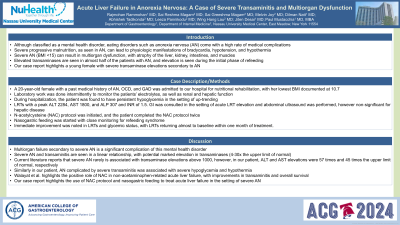Sunday Poster Session
Category: Liver
P1323 - Acute Liver Failure in Anorexia Nervosa: A Case of Severe Transaminitis and Multiorgan Dysfunction
Sunday, October 27, 2024
3:30 PM - 7:00 PM ET
Location: Exhibit Hall E


Sai Greeshma Magam, MD
Nassau University Medical Center
East Meadow, NY
Presenting Author(s)
Raj Mohan Ram Mohan, MD, Sai Reshma Magam, MD, Sai Greeshma Magam, MD, Melvin Joy, MD, Dilman Natt, MD, Abhishek Tadikonda, MD, Leeza Pannikodu, MD, Winghang Lau, MD, Jiten Desai, MD, Paul Mustacchia, MD, MBA
Nassau University Medical Center, East Meadow, NY
Introduction: Although classified as a mental health disorder, eating disorders such as anorexia nervosa (AN) come with a high rate of medical complications. Severe progressive malnutrition, as seen in AN, can lead to physiologic manifestations of bradycardia, hypotension, and hypothermia. Severe AN (BMI < 15) can result in multiorgan dysfunction, with atrophy of the liver, kidney, intestines, and muscles. Elevated transaminases are seen in almost half of the patients with AN, and elevation is seen during the initial phase of refeeding. Our case report highlights a young female with severe transaminase elevations secondary to AN.
Case Description/Methods: A 20-year-old female with a past medical history of AN, OCD, and GAD was admitted to our hospital for nutritional rehabilitation, with her lowest BMI documented at 10.7. Laboratory work was done intermittently to monitor the patients’ electrolytes, as well as renal and hepatic function. During hospitalization, the patient was found to have persistent hypoglycemia in the setting of up-trending LRTs with a peak ALT 2284, AST 1800, and ALP 307 and INR of 1.5. GI was consulted in the setting of acute LRT elevation and abdominal ultrasound was performed, however non-significant for hepatic disease. N-acetylcysteine (NAC) protocol was initiated, and the patient completed the NAC protocol twice. Nasogastric feeding was started with close monitoring for refeeding syndrome. Immediate improvement was noted in LRTs and glycemic status, with LRTs returning almost to baseline within one month of treatment.
Discussion: Multiorgan failure secondary to severe AN is a significant complication of this mental health disorder. Severe AN and transaminitis are seen in a linear relationship, with potential marked elevation in transaminases (4-30x the upper limit of normal). Current literature reports that severe AN rarely is associated with transaminase elevations above 1000, however, in our patient, ALT and AST elevations were 57 times and 45 times the upper limit of normal, respectively. Similarly in our patient, AN complicated by severe transaminitis was associated with severe hypoglycemia and hypothermia. Walayat et al. highlights the positive role of NAC in non-acetaminophen-related acute liver failure, with improvements in transaminitis and overall survival. Our case report highlights the use of NAC protocol and nasogastric feeding to treat acute liver failure in the setting of severe AN.
Disclosures:
Raj Mohan Ram Mohan, MD, Sai Reshma Magam, MD, Sai Greeshma Magam, MD, Melvin Joy, MD, Dilman Natt, MD, Abhishek Tadikonda, MD, Leeza Pannikodu, MD, Winghang Lau, MD, Jiten Desai, MD, Paul Mustacchia, MD, MBA. P1323 - Acute Liver Failure in Anorexia Nervosa: A Case of Severe Transaminitis and Multiorgan Dysfunction, ACG 2024 Annual Scientific Meeting Abstracts. Philadelphia, PA: American College of Gastroenterology.
Nassau University Medical Center, East Meadow, NY
Introduction: Although classified as a mental health disorder, eating disorders such as anorexia nervosa (AN) come with a high rate of medical complications. Severe progressive malnutrition, as seen in AN, can lead to physiologic manifestations of bradycardia, hypotension, and hypothermia. Severe AN (BMI < 15) can result in multiorgan dysfunction, with atrophy of the liver, kidney, intestines, and muscles. Elevated transaminases are seen in almost half of the patients with AN, and elevation is seen during the initial phase of refeeding. Our case report highlights a young female with severe transaminase elevations secondary to AN.
Case Description/Methods: A 20-year-old female with a past medical history of AN, OCD, and GAD was admitted to our hospital for nutritional rehabilitation, with her lowest BMI documented at 10.7. Laboratory work was done intermittently to monitor the patients’ electrolytes, as well as renal and hepatic function. During hospitalization, the patient was found to have persistent hypoglycemia in the setting of up-trending LRTs with a peak ALT 2284, AST 1800, and ALP 307 and INR of 1.5. GI was consulted in the setting of acute LRT elevation and abdominal ultrasound was performed, however non-significant for hepatic disease. N-acetylcysteine (NAC) protocol was initiated, and the patient completed the NAC protocol twice. Nasogastric feeding was started with close monitoring for refeeding syndrome. Immediate improvement was noted in LRTs and glycemic status, with LRTs returning almost to baseline within one month of treatment.
Discussion: Multiorgan failure secondary to severe AN is a significant complication of this mental health disorder. Severe AN and transaminitis are seen in a linear relationship, with potential marked elevation in transaminases (4-30x the upper limit of normal). Current literature reports that severe AN rarely is associated with transaminase elevations above 1000, however, in our patient, ALT and AST elevations were 57 times and 45 times the upper limit of normal, respectively. Similarly in our patient, AN complicated by severe transaminitis was associated with severe hypoglycemia and hypothermia. Walayat et al. highlights the positive role of NAC in non-acetaminophen-related acute liver failure, with improvements in transaminitis and overall survival. Our case report highlights the use of NAC protocol and nasogastric feeding to treat acute liver failure in the setting of severe AN.
Disclosures:
Raj Mohan Ram Mohan indicated no relevant financial relationships.
Sai Reshma Magam indicated no relevant financial relationships.
Sai Greeshma Magam indicated no relevant financial relationships.
Melvin Joy indicated no relevant financial relationships.
Dilman Natt indicated no relevant financial relationships.
Abhishek Tadikonda indicated no relevant financial relationships.
Leeza Pannikodu indicated no relevant financial relationships.
Winghang Lau indicated no relevant financial relationships.
Jiten Desai indicated no relevant financial relationships.
Paul Mustacchia indicated no relevant financial relationships.
Raj Mohan Ram Mohan, MD, Sai Reshma Magam, MD, Sai Greeshma Magam, MD, Melvin Joy, MD, Dilman Natt, MD, Abhishek Tadikonda, MD, Leeza Pannikodu, MD, Winghang Lau, MD, Jiten Desai, MD, Paul Mustacchia, MD, MBA. P1323 - Acute Liver Failure in Anorexia Nervosa: A Case of Severe Transaminitis and Multiorgan Dysfunction, ACG 2024 Annual Scientific Meeting Abstracts. Philadelphia, PA: American College of Gastroenterology.
